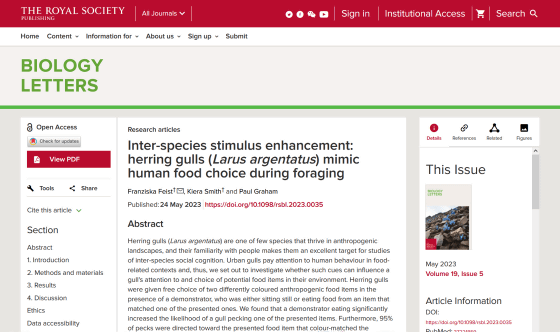Experiments show that seagulls identify and prefer to steal ``the same food that humans have''

When you hear that 'a seagull attacks and robs you of food', it seems like an event in a manga or anime, but when you actually eat on the beach or on a ship, seagulls take food from your hands. there is. Scientists have been conducting research on 'Why do seagulls take away
Inter-species stimulus enhancement: herring gulls (Larus argentatus) mimic human food choice during foraging | Biology Letters
https://doi.org/10.1098/rsbl.2023.0035

Greedy gulls decide what to eat by watching people -- new research
https://theconversation.com/greedy-gulls-decide-what-to-eat-by-watching-people-new-research-206144
Herring gulls that live in Europe inhabit coasts and estuaries, but in recent years they have begun to breed in colonies near cities, and they are increasingly interacting with humans. In the process, herring gulls have learned to actively steal food from humans, and past studies have shown that `` seagulls come to steal food during school lunch breaks ,'' It is known that they prefer food that has been placed on the ground after it has been washed.
Seagulls tend to prefer ``food held by humans''-GIGAZINE

A new study by Paul Graham , a neurobehavioral professor at the University of Sussex, and colleagues found that seagulls can not only track objects touched by humans, but also ``see objects in space as objects that humans are manipulating. An experiment was conducted to compare and see if it can be judged to be the same. The ability to compare different objects and determine if they are the same suggests a higher level of cognitive ability than just object tracking.
The research team placed two differently colored snack bags a few meters away from the seagulls on the beach. The researcher sat a little away from there and said that he had a bag of the same color as one of the two bags of snacks placed in his hand.

When we investigated which of the two bags the seagulls were interested in, 95% of the seagulls who tried to steal the bag said, It was confirmed that he poked the bag of This indicates that the seagull recognized ``the bag held by the researcher'' and ``the bag of the same color placed on the sandy beach'' as the same thing, and tried to steal it with priority.
Graham said that most of the seagulls who tried to steal the bag were adults, suggesting that stealing food requires boldness and skill that young seagulls do not have.

Herring gulls began interacting frequently with humans about 80 years ago. . “In any event, any attempt to minimize collisions with gulls should take into account their superior observational abilities, rather than simply avoiding feeding them,” Graham said. rice field.
Related Posts:






